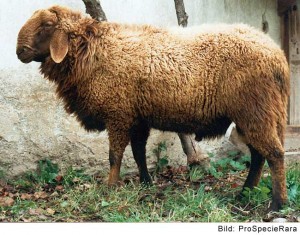Engadinerschaf (CH)
Description
It is a medium to large-framed sheep with Roman head and long and broad lop ears, fox-coloured or black. The long, rather straight and coarse wool can turn grey at old age. Females sometime have a white star and tail. Hind legs to the hock joint are woolly, but not the front legs. Ankles are of medium length and strong with hard claws. The animals are non-seasonal and very fertile with 3 lambs/year on average. First lambing is possible at the age of 14 month.
General and History
The Red Engadine or Besch da Pader has its origin in the Lower Engadine and traces back to local sheeps breed, Steinschaf and Bergamasca. In the 1980ies, the breed was nearly extinct. A herdbook was founded in 1992. A special breeding program exists in the period between 1997-2005.
Distribution in the past and today
Red Engadine is today bred in whole Switzerland, whereby population numbers are increasing. Animals are mostly kept as hobby or by part-time farmers.
Utilization
Meat and wool are produced on marginal sites.
Keeping
This very fertile breed is robust, frugal and undemanding. It is suited for high mountains and rarely contracts foot rot because of its hard claws. Red Engadine is well suited for the management of marginal sites.
Performance
Body weight: 75-125kg (m), 55-90kg (w)
Withers height: 66-88cm (m), 59-80cm (w)
Lambing percentage: 175%
Processing and products
The wool was used earlier for loden cloth and monk's habits (therefore "Paterschaf"). Today for carpets, beds and insulating materials. Besides, the wool is suited very well to the felt. The fur is tanned and mostly serves for the decoration of floors.
The meat of Engandinerschaf lambs is an absolute delicacy and differs in positive regard from the conventional lamb meat.
Literature
· Etienne Bendel (1992): Populationsanalyse des Engadinerschafs
· ProSpecieRara: Nutztierkompass, Basel, 2012 (https://www.prospecierara.ch/de/shop/article/nutztierkompass)
· Schafrassen in den Alpen, Antje Feldmann, Ursula Bietzker, Dr. Christian Mendel, Gesellschaft zur Erhaltung von alten und gefährdeten Haustierrassen e.V. - GEH.
· Brochure «Ressources zoogénétiques de l’agriculture suisse», 20.09.2021, Office Fédéral de l'Agriculture, OFAG








